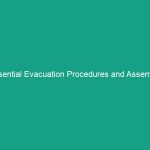Introduction
Good morning team,
Today, we’re going to discuss an incredibly important topic: Essential Severe Weather Safety Tips. Severe weather can hit unexpectedly, and it’s crucial that we are prepared to protect ourselves and each other in the workplace. Understanding how to respond effectively to severe weather can mean the difference between Safety and danger.
Let’s dive into why this topic is vital for our workplace and how we can all contribute to a safer Environment.
Understanding Essential Severe Weather Safety Tips
Severe weather includes conditions like thunderstorms, tornadoes, hurricanes, heavy snow, and extreme heat. Each of these phenomena carries specific risks that can impact our safety and productivity.
Many people believe that severe weather is a rare occurrence, but studies show that the frequency and intensity of these events are increasing due to climate change. This makes it essential for all of us to remain vigilant and prepared.
Key Hazards, Risks, and Safety Considerations
Severe weather can introduce several Hazards, including:
- High Winds: Can cause structural damage, flying debris, and power outages.
- Flooding: Poses risks of water damage, Electrical Hazards, and transportation issues.
- Extreme Temperatures: Heat can lead to heat exhaustion or heat stroke, while extreme cold can result in hypothermia.
- Lightning: Can cause injuries or fatalities, especially for individuals working outdoors.
Ignoring safety protocols during these events can result in serious injuries, loss of property, and even fatalities. It’s essential that we recognize these risks and take proactive measures to mitigate them.
Best Practices, Procedures, & Actionable Advice
Preparation Before Severe Weather Strikes
Preparation is key to ensuring safety during severe weather. Here are some actionable steps:
- Stay Informed: Regularly check weather forecasts and alerts through trusted sources such as the National Weather Service.
- Emergency Plans: Develop and communicate an emergency response plan that includes evacuation routes, assembly points, and contact information.
- Emergency Kits: Ensure your team has access to emergency kits that include essentials such as water, non-perishable food, first-aid supplies, and flashlights.
During Severe Weather Events
When severe weather occurs, follow these steps:
- Seek Shelter: Move to designated shelter areas immediately. This could be a basement, an interior room, or a designated storm shelter.
- Stay Indoors: Avoid going outside until it is safe. Many injuries occur from debris during storms.
- Communicate: Keep communication lines open. Use mobile devices or radios to stay updated on weather alerts. Check in with team members to ensure everyone is accounted for.
Post Severe Weather Safety Measures
After severe weather has passed, take the following Precautions:
- Assess Damage: Carefully check for any damage to the building or surrounding area before re-entering.
- Report Hazards: Immediately report any hazards such as downed power lines or structural damage to the relevant authorities.
- Emotional Support: Severe weather can be traumatic. Ensure that team members have access to support services if needed.
Regulations, Standards, and Compliance
It’s essential to adhere to safety Regulations set forth by OSHA and other safety organizations. These Standards not only protect employees but also ensure that the workplace is compliant with legal requirements.
For example, osha recommends that employers develop a severe weather preparedness plan as part of their Emergency Action Plan. Compliance with these standards is critical for maintaining safety and protecting our workforce.
Employee Engagement & Discussion
Let’s open the floor for discussion. What safety challenges have you encountered related to severe weather? Have you witnessed or experienced an incident that you believe could have been prevented with proper Precautions?
Your insights are invaluable, and sharing experiences can help us all learn and improve our safety practices.
Conclusion & Key Takeaways
To summarize, severe weather presents a range of risks that we must be aware of and prepared for. By understanding the hazards, following Best Practices, and remaining compliant with safety regulations, we can protect ourselves and our colleagues.
Remember, safety is a shared responsibility. Let’s commit to prioritizing it and supporting one another in our efforts. Thank you for your attention today, and let’s work together to ensure a safe and secure workplace!


